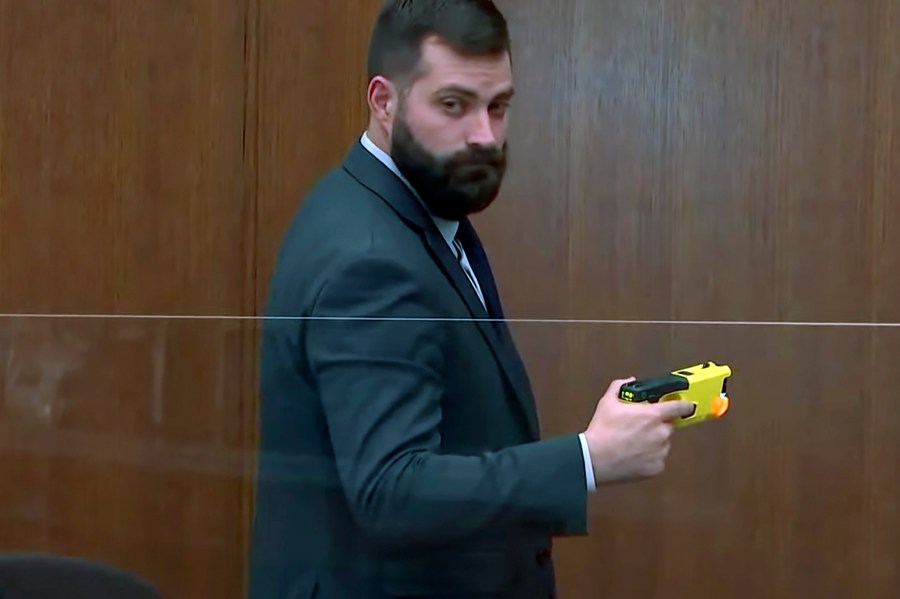MINNEAPOLIS (AP) — The suburban Minneapolis police officer who shot and killed Daunte Wright with her handgun when she said she meant to use her Taser was fully trained in her department’s policies on the proper use of force, including the stun guns, a police commander testified Tuesday.
Kim Potter, who resigned two days after she shot Wright, was trained on policies as they evolved during her 26-year career and repeatedly signed documents acknowledging the policies, Brooklyn Center Police Commander Garett Flesland testified.

Potter, 49, is charged with manslaughter in Wright’s death on April 11 after he was pulled over for having expired license plate tags and an air freshener dangling from his rear-view mirror. Video captured the moments when Wright pulled away from officers who were trying to arrest him on an outstanding warrant, with Potter shouting “I’ll tase you!” and then shooting Wright with her handgun.
Potter is white and Wright was Black, and his death set off several nights of angry protests in Brooklyn Center. It happened while a white former officer, Derek Chauvin, was on trial in nearby Minneapolis in George Floyd’s death.
The defense has called the shooting a horrific mistake, but has also asserted that Potter would have been within her rights to use deadly force on Wright because he might have dragged another officer, then-Sgt. Mychal Johnson, with his car.
Prosecutors introduced several documents Tuesday that Flesland testified showed Potter’s repeated certifications on Taser training, and her awareness of the warnings for their use — including a certification the month before Wright was shot.
On cross-examination, Potter attorney Earl Gray hammered away at her right to use force. He repeatedly described the situation as one in which Potter was trying to stop a wanted person who was trying to flee from the police and who could have put a fellow officer at risk of being dragged by a car.
“You’ve got to save that officer that’s laying over the seat, correct?” Gray asked.
“Yes,” Flesland said.

Later, when Gray asked Flesland what he thought of Potter, he said: “She’s a good cop. She’s a good person. She’s a friend. I have no concerns going to calls with her.” Prosecutors objected.
Flesland also testified that he and the police chief at the time had gone to Potter’s house the day of Wright’s shooting because “we had been told she had hurt herself.” That line of questioning was cut off after prosecutors objected.
Earlier Tuesday, Judge Regina Chu denied two motions filed by prosecutors. One was designed to limit the opinion of witnesses who are not testifying as experts. That came after Johnson, who is now a major in a sheriff’s office near Minneapolis, testified last week that Potter’s actions were authorized under state law. Johnson was not testifying as an expert on the police use of force.
“I’m not going to preclude any of the officers from testifying that, based upon their training and experience, that deadly force or use of Taser was appropriate under the circumstances,” Chu said.
She also denied prosecutors’ request to question police officers about union membership. They argued that Potter had roles in the union, including as president, that gave her an elevated level of respect among her coworkers. They wanted to ask officers about it so that jurors could evaluate any potential bias toward Potter.
Chu said she rejected the motion because Potter is no longer connected to the police union in any way and testifying witnesses “couldn’t possibly be biased to testify in her favor because of her position.”
Chu also ruled Tuesday that if Potter is convicted of one or both of the counts against her, she would preside over a separate trial to determine if there were aggravating factors that would allow Chu to give Potter a sentence above what the state’s guidelines suggest.
Prosecutors had been operating under the impression that these issues would be presented during this trial, but without the jury present, Gray said Potter had never agreed to that.
In order for Potter to be sentenced above what the guidelines suggest, prosecutors would have to prove there were aggravating factors; prosecutors allege that Potter’s conduct caused a danger to others and that she abused her position of authority.
Prosecutors presented evidence of these aggravating factors when they brought in testimony about injuries to Wright’s passenger and an occupant of the car that collided with Wright’s right after Potter shot him. Chu said Tuesday that this testimony was not prejudicial and could remain part of this case because evidence about the crash also relates to whether Potter’s use of force was reasonable.

Prosecutors on Monday put the differences between her handgun and her Taser on display for jurors, seeking to raise questions about how an experienced officer could confuse the weapons.
Sam McGinnis, a senior special agent with the state’s Bureau of Criminal Apprehension, highlighted the differences in the way they were holstered on Potter’s duty belt. He also noted the handgun’s weight — at about 2 pounds, more than twice that of the Taser — as well as differences in triggers, grips and safety mechanisms.
McGinnis also testified that the Taser has a laser and LED lights that display before it is fired, which he demonstrated for the jury, while the handgun does not, he said.
The case is being heard by a mostly white jury.
State sentencing guidelines call for just over seven years in prison upon conviction of first-degree manslaughter and four years for second-degree, though prosecutors have said they plan to push for longer sentences.





































